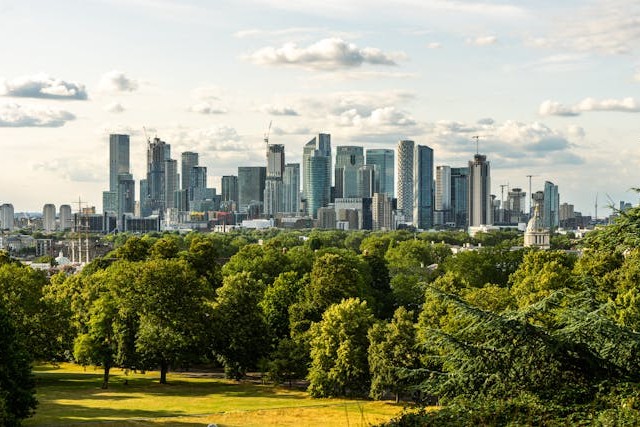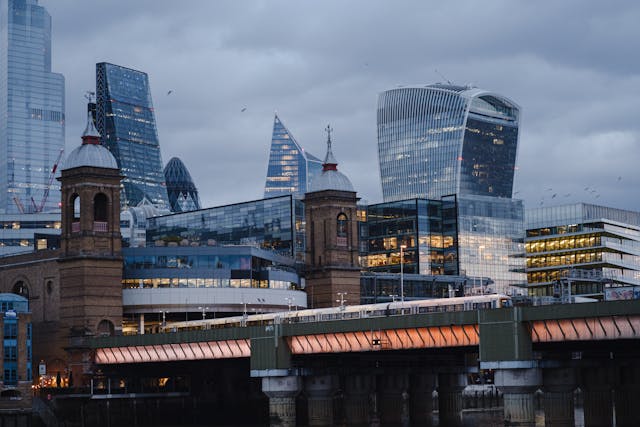
Cost to Rent Office Space in London: At-A-Glance
| Aspect | Central London | Outskirts/Outer Boroughs |
| Cost | High rents and high business rates. £70-£88 / sqft for Grade A office space in The City. | Lower rents and overheads. Averages of £30 / sqft for North London outskirts locations. |
| Startup survival | Prone to burn through capital | Extended runway boosts resilience |
| Brand signal | Conveys prestige and trustworthiness | Matches modern and agile brand narratives |
| Ideal sectors | Finance/Insurance/Legal startups | Tech and creative |
For startups in London, choosing an office location isn’t just a logistical decision: it’s a strategic move with real implications for cost control, client perception, and long-term survival. The choice between setting up a serviced office space in central London postcodes or in the outskirts is often one of the most important financial decisions a company will face at its earliest stage.
To help with that decision, in this article, we offer a data-driven analysis of the pros and cons of each option to rent office space, comparing costs, survival rates, and brand impact from central London and outer borough offices.
Cost Comparisons – Central London vs London Outskirts
– Central London
Central London Office Rental Costs: Data from 2025 shows the following rent averages:
The City Core averages £120 / sqft for prime office space
West End averages £157 / sqft with a top rent of £220 / sqft achieved in the previous quarter
Grade A (highest quality office space)
The City – £70-£88 / sqft
West End – £88-£115 / sqft
Southbank – £90 / sqft
Canary Wharf – £57.50 / sqft
Grade B
The City – £41.65 / sqft
West End – £55.95 / sqft
Southbank – £67.5 / sqft
Insight: In the City and the West End, rental costs are showing signs of strong recovery, experiencing double-digit growth in just 2 years. This trend is expected to remain, also driving up costs for Grade B offices due to the limited availability and supply pipeline of Grade A space. Keep this in mind when considering potential cost increases that could impact your startup.
Office size:
53% of all office units in central London are under 5,000 sqft, although this varies by location. For example, in 2025, 39% of all City deals and 27% of all Southbank transactions were for units of 20,000 square feet and above.
Insight: These areas have a strong presence of corporates and large finance firms, which are not in the same position as startups when it comes to available capital to invest when they rent office space.
Business rates:
City Core – £35.93
West End – mid £30s to mid £40s, except for St James (£70.51) and Mayfair (£67.31)
Overall, net effective costs for West End offices are just over £200 sqft / year – making it the priciest office market in London.

– London Outskirts
Greater London and Outer Boroughs’ Office Rental Costs:
North London outskirts (e.g. Watford)
- Prime rents at £43 / sqft with up to 27 months rent free for long-term leases, otherwise averages of £30 / sqft.
- Preferred by professional services firms.
West London outskirts (e.g. Westfield, White City, Chiswick, and Ealing)
- Prime rents average £63 / sqft.
- Preferred by firms in pharma, healthcare, and life sciences due to availability of large floorplates (20,000 sqft and above) and ease of finding Grade A premises (81% of the total available stock).
Other popular non-core London office locations:
Docklands – £57.5 / sqft
Croydon – £41 / sqft
White City – £44.5 / sqft
Hammersmith – £42.75 / sqft
Hackney – £35 / sqft
Brentwood – £29 / sqft
Dartford – £23 / sqft
Demand trends for outer London office space
In Greater London, the most in-demand areas are Thames Valley and Heathrow/Stockley, where average rents are as follows:
Bracknell – £30 / sqft
Slough – £36 / sqft
Heathrow – £36 / sqft
Reading – £51 / sqft
Maidenhead – £52.5 / sqft
Most companies choosing office space in peripheral locations go for Grade A space. For example, in South West London (including Richmond, Wimbledon, Clapham, Putney, Kingston, New Malden, and Twickenham), 83% of all transactions between 2019 and 2024 involved Grade A units.
Office size:
Most non-core deals involve offices between 9,000-24,000 sqft.
In Greater London, the majority of leases fall within the 5,000-9,000 sqft range.
Business rates:
These are substantially lower in non-core sub-markets, going from £18 in Stratford to £24 in Battersea.
Insight: In 2026, business rates are set to rise by an average of 9% in central London, but not in peripheral locations – keep this in mind when considering potential cost increases that could impact your startup.

Startup Survival Rates
Startup survival is an uphill battle: 60% of new businesses fail within their first three years, often due to cash flow pressures. Let’s see what the data says about how different London areas impact survival outcomes.
- London-wide, the startup failure rate is 41%, being somewhat lower in Thames Valley locations like Slough, where it’s 38%.
- Only one London location is in the top 10 of best survival rates in the UK: Hackney, with 36%.
A breakdown of London boroughs points to outer boroughs having the best startup survival chances. The top 3 locations are:
- Bromley (in London’s South East) has a 46.63% startup survival rate
- Harrow (in the North West) 45.16%
- Hounslow (near Heathrow in West London) 44.34%
Kensington and Chelsea, just west of the city core, come in 11th position with 41.77% of startups surviving. By contrast, central London locations have some of the lowest rates of success for new ventures, with the City at 39.78% and Westminster at 38.62%.
Boroughs with the lowest startup survival rates (all under 37%) are Barking-Dagenham, Tower Hamlets, and Newham.
Brand Image & Location
Location plays a role in brand image, and this is indirectly related to startup survival outcomes. In sectors like finance, being based in a prime London office building address can offer a reputational edge. It’s no coincidence that 34% of take-up in central London offices is driven by finance and insurance firms – 39.4% of those specifically in the City and Southbank, whereas 34.2% of West End take-up comes from this sector.
On the other hand, creative startups can benefit from being based in culturally vibrant London neighbourhoods that better reflect their brand’s ethos. This is the case of Hackney and Fish Island, where creative jobs have increased by 60% since 2018, and where rental costs are on average 50% lower than in the City.
Better to rent an Office in Central London or the Outskirts? Summarising the Pros and Cons of Each Location
When comparing London’s core with the city’s outskirts, it’s useful to weigh your decision by looking at these four dimensions:
1. Cost
Startups in areas like the West End or Canary Wharf not only face high rent prices, but also significant additional expenses, like higher business rates. In contrast, offices in the outskirts usually come with cost savings and lower operational overheads. Districts such as Hackney, Croydon, and Romford offer office rates that can be less than half those in central London.
2. Survival potential
From a business survival standpoint, the high capital requirements needed for central London offices can erode a startup’s finances quickly. With lower overheads, outer London locations can help businesses stabilise their bottom line during the critical first 5 years.
3. Brand signal
A central London office conveys authority and trust, which are particularly valuable for startups in finance or legal sectors. By contrast, an address in a creative quarter or at an emerging tech hub can signal agility, innovation, and cultural relevance, which aligns well with the mission of many tech and design startups.
4. Industry sector
Finance, insurance, and law startups tend to cluster in London’s core postcodes, where proximity to clients and customers, regulators, and institutional investors is crucial. Meanwhile, tech, creative, and small-to-medium-sized businesses increasingly favour outer boroughs for their flexibility, affordability, and alignment with brand values.

Conclusion
Choosing between an office in the London city centre and one in the outskirts comes down to strategic alignment. Central London offers prestige, access to key clients, and a strong brand signal, being especially well-suited to startups in the finance and legal sectors. However, high rents and rising business rates can squeeze early-stage budgets.
On the other hand, outer boroughs offer cost-efficiency, higher survival odds, and alignment with creative and tech brands. So what’s the verdict? For startups, the right location isn’t always central, but it should always be chosen intentionally and based on data.
Looking for expert help securing the right office space in London—for free?
Whether you’re negotiating with landlords or evaluating offers from office space providers, having a professional by your side can give you a real advantage. At London Office Space, our experienced brokers do more than just set up viewings – they become a trusted part of your team throughout the entire process.
Every business has its own future goals, challenges, and operational style, so a one-size-fits-all solution won’t work. We tailor our approach to match your company’s specific needs, whether you’re launching a new venture, working as a sole trader, or managing a well-established team. Our goal is to help businesses of all sizes and industries access the best office solutions across Central and Greater London.
You don’t need to navigate the commercial property market alone. A knowledgeable broker can mean the difference between settling for something adequate and finding a space that becomes an investment, one that truly fits your brand, budget, and plans for growth.
Call us now on 020 3965 9617 to speak with one of our office space experts or use our search function to browse our extensive range of office space in London, add a few of your favourite serviced offices, private executive suites, or coworking centres to your wishlist, then click ‘Get A Quote.’ One of our friendly workspace specialists will then be in touch shortly.
To learn more about the commercial real estate market in London and about other trending business-related topics, check out some of our other recent articles:
Average Office Space Requirements for Different Industries: A Data-Driven Analysis
What is an Office Brokerage—and Why Use One to Find Office Space in London?
What is BREEAM Certification? Sustainable Office Design in London
London Commercial Space Trends
Return to Office: UK Workers Surveyed About RTO Mandates
Office Christmas Party Ideas: Not the Traditional, Boozy ‘Do
The Most Haunted Places in London, England: Office Buildings Edition
Gen Z in the Workplace: A Comprehensive Guide
